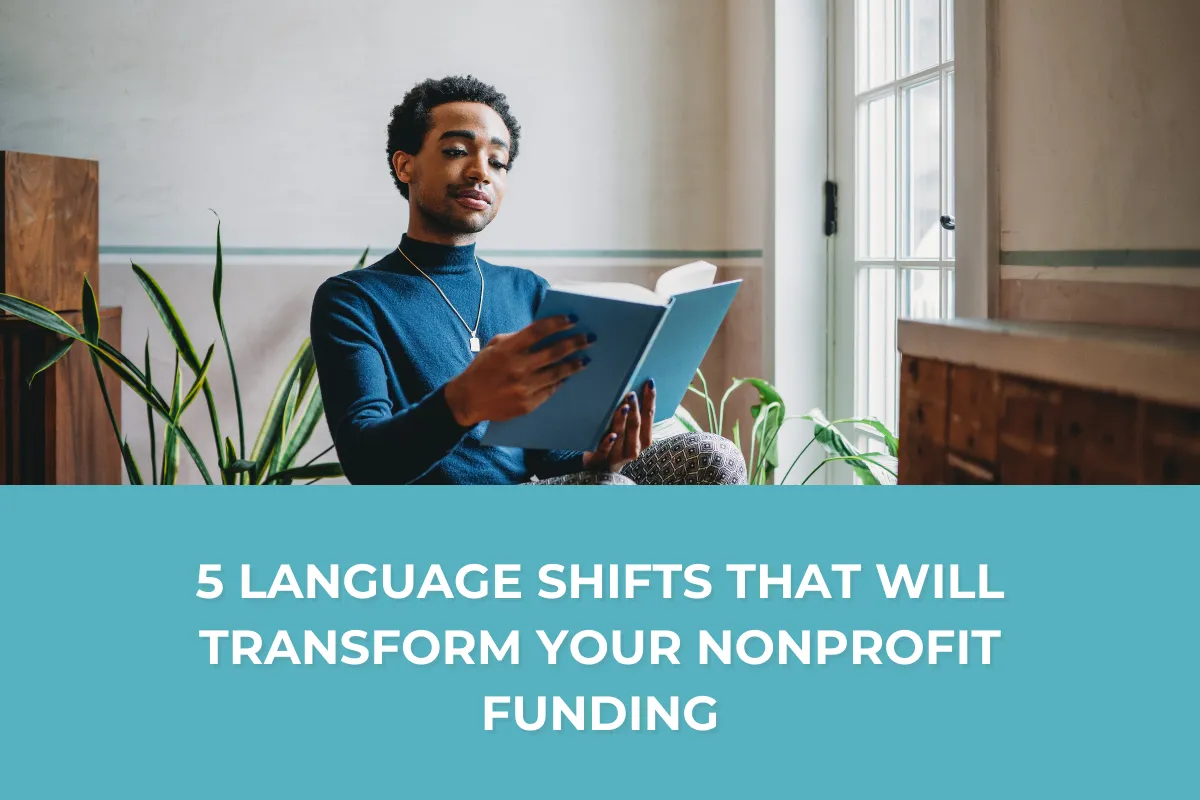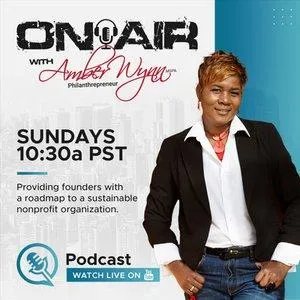
5 Language Shifts That Will Transform Your Nonprofit Funding
You're doing incredible work. You've been serving your community for years, making a real impact and building trust. So why isn't the funding flowing like it should?
The funding landscape has never been more challenging. Federal budget cuts have eliminated grants that nonprofits relied on for decades, while increased regulatory scrutiny means Funders are more cautious about where they invest their dollars.
The national average success rate for nonprofit grant applications is roughly 10% across the board—only one in every 10 proposals submitted gets approved and funded. Meanwhile, 70% of nonprofits cite board-led fundraising as a significant challenge, and the competition is only getting fiercer as more nonprofits are founded each year while the pool of available funding remains essentially the same.

In this environment, even established organizations with strong track records are finding themselves fighting for resources that once came more easily. Funders are demanding more strongly quantifiable measurements and prioritizing organizations that can clearly demonstrate alignment with their strategic objectives.
But the fact is: Your programs aren't the problem. Your positioning is.
After working with hundreds of nonprofit leaders, I've discovered that the organizations that consistently secure funding aren't necessarily doing better work—they're just speaking a different language. The language of Funders.
The Positioning Problem Most Nonprofits Don't Realize They Have
Most nonprofit founders start with their hearts. They're passionate about their cause, committed to their community, and driven to make change. But here's what they don't realize: The purpose of a nonprofit Funder is not to fund organizations—it's to achieve their own funding goals.
Think about it from a Funder's perspective. When a foundation president stands before their board of trustees, or when a government official reports to Congress, they need to demonstrate concrete returns on investment. They're not looking for organizations to save—they're looking for strategic partners who can help them show measurable outcomes that get them closer to accomplishing their funding goals.
This fundamental misunderstanding is why so many grant proposals get rejected before they're even reviewed. Founders write grants saying, "I need you to fund my nonprofit" or "I need you to help these kids," when they should be saying, "Here's how we can help you accomplish your funding goals ."
The difference? The first approach positions you as a charity case seeking rescue. The second positions you as a competent partner offering solutions. Funders don't invest in problems—they invest in proven solutions that advance their own strategic goals.
This isn't about being manipulative or inauthentic. You're doing the same vital work either way. It's about translating your impact into the language that decision-makers use when they evaluate whether an investment will help them succeed.
The Language of Funding: Outcomes, Data, and Strategic Alignment

Successful funding language has three core components:
1. Outcomes: You can clearly explain what will happen as a result of their investment. Not activities, not good intentions—measurable changes in people's lives or communities.
2. Data: You present concrete evidence of your impact. Numbers don't lie, and they give Funders the proof that you can deliver on your promises. It’s a requirement to justify their investment.
3. Strategic Alignment: You demonstrate clear understanding of the Funder's goals and show exactly how your work advances their mission.
So, how do you make this translation? It comes down to five specific language shifts that consistently funded nonprofits have mastered. These aren't complex strategies or expensive rebranding efforts. They're strategic word choices that immediately signal to Funders that you understand their priorities and can deliver the outcomes they need to achieve their goals.
The 5 Language Shifts That Will Transform Your Funding Success
1. From "Help Us" to "Help You Achieve"
Instead of saying: "With your funding, we can help strengthen communities and build confidence in individuals."
Say this: "Our evidence-based programs have reduced youth unemployment by 40% in low-income neighborhoods, breaking cycles of poverty, and creating a new pipeline of STEM-focused professionals.”
Funder’s Goals: Break generational cycles of poverty in disinvested communities by creating youth employment opportunities that will reduce crime and lead to a stronger STEM-based workforce
What Funders hear: "This organization understands our funding goals, areas of focus, and desirable outcomes. They can provide the program that our board and stakeholders will agree can accomplish our overarching goals."
When funders can clearly see how your results will help them demonstrate success to their oversight bodies, you become an investment rather than an expense.
2. From Vague Mission to Laser-Focused Impact
Instead of saying: "We serve everyone from ages 0 to 85 in our community, providing comprehensive support services."
Say this: "We specialize in helping justice-involved youth ages 16-24 develop entrepreneurship skills, with 78% of participants launching sustainable businesses within 12 months."
What Funders hear: "This isn’t an overstretched organization, serving everyone, and diluting its impact—they're specialists who can deliver concentrated impact in our priority area."
Focused expertise signals efficiency and effectiveness, two qualities that make Funders confident in their investment decisions.
3. From Need-Based to Outcome-Driven
Instead of saying: "Our organization needs funding to continue keeping our doors open and serving our community."
Say this: "Over the past three years, our beach cleanup initiatives have removed 10 tons of debris, directly improving marine ecosystem health and water quality for 50,000 coastal residents."
What Funders hear: "This organization is financially stable and solution-focused—they're offering partnership, not asking for a bailout."
Organizations that lead with outcomes rather than needs appear sustainable and strategic, reducing the Funder's perception of reliance and dependence.
4. From Problem-Focused to Solution-Oriented
Instead of saying: "There are so many challenges in our community: poverty, lack of education, unemployment, and limited resources."
Say this: "Through our workforce development program, we've placed 250 previously unemployed residents into living-wage careers, contributing $3.2 million in new household income to the local economy."
What Funders hear: "This organization doesn't just identify problems—they solve them effectively and can prove it."
Evidence-based results language demonstrates competency and reliability, making it easy for Funders to justify their investment internally.
5. From General Impact to Strategic Alignment
Instead of saying: "We make a difference in people's lives through our various programs and services."
Say this: "Our literacy intervention program improves reading proficiency scores by an average of 2.3 grade levels, closing the achievement gap in underserved communities."
What Funders hear: "This organization has done their homework. They understand our mission and can directly advance our goal to close the achievement gap in underserved communities."
Strategic alignment language eliminates guesswork and shows Funders exactly how their investment will create the specific impact they need to achieve.

🔔 For a more comprehensive guide on how to speak the language of funders (and win grants), read my book, “Grant Writing Proposal Simplified: How to Answer RFP Questions.”
🔍 Quick Website Audit: Make These Changes Today
Transform your online presence with these immediate improvements:
Clarify Your Mission Statement
Make it specific and outcome-focused
Eliminate vague language like "strengthen communities" or "empower individuals"—replace it with specifics like “reduce crime rates” or “increase graduation rates”
Include your target population and the change you create: “Increase high school graduation rates by 25%”
Add Data to Your Homepage
Post impact statistics prominently (“Assisted 200 youth with securing full-ride scholarships to 4-year universities”)
Include numbers served since inception (“Trained 2,500 justice-impacted women to become union-based construction workers”)
Highlight specific outcomes achieved (“98% of our clients have not returned to prison after 4 years of graduating our program”)
Show measurable community changes (“Crime has dropped 27%; homeownership has increased by 33%; Teen pregnancy has reduced by 20%”)
Demonstrate Strategic Thinking
Narrow your target audience (stop trying to serve everyone)
Define your geographical service area
Position yourself as a subject matter expert
Show sustainable organizational structure
Here’s what this could look like for the nonprofit “Phoenix Young Entrepreneur Institute”
BEFORE
Mission: "We strengthen communities and empower individuals through various programs and services to help everyone in need."
Homepage text: "Phoenix Young Entrepreneur Institute has been serving our community for 8 years. We work with families, youth, seniors, and individuals facing challenges. We provide support services and hope to continue helping people if we can secure more funding to keep our doors open."
AFTER
Mission: "Phoenix Young Entrepreneur Institute transforms unemployed young adults ages 18-24 into skilled entrepreneurs through intensive 6-month business incubation programs."
Homepage text: "Since 2016, Phoenix Young Entrepreneur Institute has launched 127 businesses, creating 340 jobs and generating $2.8M in new revenue for the South Phoenix economy. Our graduates achieve an 84% business survival rate after 2 years—nearly double the national average for new businesses."
Impact statistics prominently displayed:
127 businesses launched since inception
84% two-year business survival rate
$2.8M in new community revenue generated
340 jobs created in target zip codes 85040-85042
Notice how the transformation creates immediate credibility: specific target audience, concrete outcomes, measurable community impact, and clear expertise in entrepreneurship development rather than vague "community strengthening."
🔔 Learn how to Create a Funder-Ready Nonprofit Website
The Bottom Line: You Don't Have a Funding Problem
You have a positioning problem. And that's actually good news, because positioning is much easier to fix than programmatic issues.
The organizations that secure funding consistently haven't cracked some secret code—they've simply learned to speak the language that Funders understand. They've shifted from a founder's perspective (internal needs and challenges) to a Funder's perspective (external goals and outcomes).

The work you do is important. Your community needs you. But if you want sustainable funding to continue that work, you need to communicate its value in the language that Funders speak.
Repeat after me: Grants aren't free money—they're investments. And investors want to see clear returns. When you position your organization as a strategic partner who can deliver measurable outcomes that align with their goals, funding follows.
The question isn't whether you're doing good work. The question is: Are you communicating that work in a way that Funders can see their own success reflected back at them?
Make these language shifts, and watch how quickly your funding landscape changes. Because at the end of the day, you're doing the same important work—now, you're speaking about it in a way that Funders can hear.
Ready to dive deeper into strategic nonprofit positioning? These language shifts are just the beginning. The most successful nonprofits have comprehensive strategies that align every aspect of their organization—from board development to program design—with sustainable funding practices.
If you're ready to transform your nonprofit from struggling for funding to consistently securing the resources you need, the Nonprofit Mastery Academy provides the complete roadmap.

Inside the Academy, you'll get step-by-step guidance on positioning your organization for consistent outside funding, identifying active and engaged board members, creating winning funding strategies, and diversifying your revenue streams. Don't let another grant cycle pass by while your community waits for the resources it needs. Join the Academy today.
💡 For more ideas on fundraising for your nonprofit (you know I always say, a nonprofit can’t survive on grants alone!), grab my book, “Beyond Grants: The Nonprofit Guide for Creative Fundraising Ideas.”








